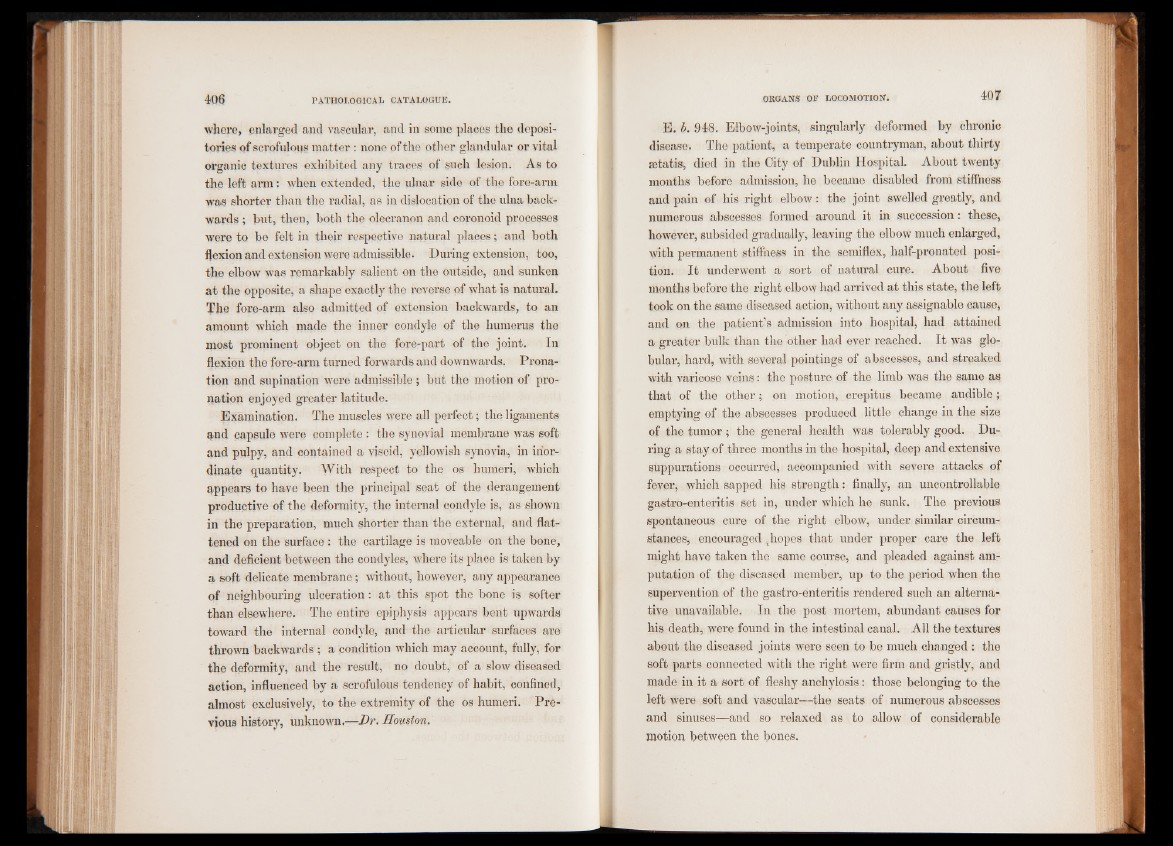
where, enlarged and vascular, and in some places the depositories
of scrofulous matter : none of the other glandular or vital
organic textures exhibited any traces of such lesion. As to
the left arm: when extended, the ulnar side of the fore-arm
was shorter than the radial, as in dislocation of the ulna backwards
; but, then, both the olecranon and coronoid processes
were to be felt in their respective natural places; and both
flexion and extension were admissible. During extension, too,
the elbow was remarkably salient on the outside, and sunken
at the opposite, a shape exactly the reverse of what is natural.
The fore-arm also admitted of extension backwards, to an
amount which made the inner condyle of the humerus the
most prominent object on the fore-part of the joint. In
flexion the fore-arm turned forwards and downwards. Pronation
and supination were admissible ; but the motion of pronation
enjoyed greater latitude.
Examination. The muscles were all perfect; the ligaments
and capsule were complete : the synovial membrane was soft
and pulpy, and contained a viscid, yellowish synovia, in inordinate
quantity. With respect to the os humeri, which
appears to have been the principal seat of the derangement
productive of the deformity, the internal condyle is, as shown
in the preparation, much shorter than the external, and flattened
on the surface : the cartilage is moveable on the bone,
and deficient between the condyles, where its place is taken by
a soft delicate membrane; without, however, any appearance
of neighbouring ulceration : at this spot the bone is softer
than elsewhere. The entire epiphysis appears bent upwards
toward the internal condyle, and the articular surfaces are
thrown backwards ; a condition which may account, fully, for
the deformity, and the result, no doubt, of a slow diseased
action, influenced by a scrofulous tendency of habit, confined,
almost exclusively, to the extremity of the os humeri. Previous
history, unknown.—Dr. Houston.
E. h. 948. Elbow-joints, singularly deformed by chronic
disease. The patient, a temperate countryman, about thirty
affatis, died in the City of Dublin Hospital. About twenty
months before admission, he became disabled from stiffness
and pain of his right elbow : the joint swelled greatly, and
numerous abscesses formed around it in succession : these,
however, subsided gradually, leaving the elbow much enlarged,
with permanent stiffness in the semiflex, half-pronated position.
It underwent a sort of natural cure. About five
months before the right elbow had arrived at this state, the left
took on the same diseased action, without any assignable cause,
and on the patient’s admission into hospital, had attained
a greater bulk than the other had ever reached. It was globular,
hard, with several pointings of abscesses, and streaked
with varicose veins: the posture of the limb was the same as
that of the other; on motion, crepitus became audible;
emptying of the abscesses produced little change in the size
of the tumor; the general health was tolerably good. During
a stay of three months in the hospital, deep and extensive
suppurations occurred, accompanied with severe attacks of
fever, which sapped his strength: finally, an uncontrollable
gastro-enteritis set in, under which he sunk. The previous
spontaneous cure of the right elbow, under similar circumstances,
encouraged , hopes that under proper care the left
might have taken the same course, and pleaded against amputation
of the diseased member, up to the period when the
supervention of the gastro-enteritis rendered such an alternative
unavailable. In the post mortem, abundant causes for
his death, were found in the intestinal canal. All the textures
about the diseased joints were seen to be much changed : the
soft parts connected with the right were firm and gristly, and
made in it a sort of fleshy anchylosis : those belonging to the
left were soft and vascular—the seats of numerous abscesses
and sinuses—and so relaxed as to allow of considerable
motion between the bones.